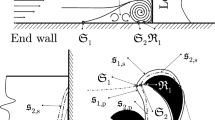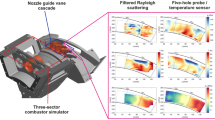Abstract
In this study, the local jet velocity distribution for a combined impingement and film cooled high-pressure nozzle guide vane system was analyzed, using flow visualization and PIV-assisted measurement. The measurements including flow visualization were performed on the stagnation row of an NGV to understand its complex flow pattern. PIV technique was used to measure the effused coolant jet exit velocity field in two-dimensional vertical planes. The computations were performed by ANSYS FLUENT 14.5 SOLVER using shear stress transport (SST) k-ω turbulence model. Three laboratory test cases that correspond to inlet coolant mass flow rates of 0.0032, 0.0045 and 0.0054 kg/s, at the region of an FIT, were studied. The numerical results for the spanwise coolant velocity at stagnation row of the film holes agreed well with the PIV experimental data on the same vane configuration.
Graphical Abstract











Similar content being viewed by others
Abbreviations
- FIT:
-
Front impingement tube
- PIV:
-
Particle image velocimetry
- d :
-
Film hole diameter, m
- V j :
-
Jet exit velocity, m/s
- \(\dot{m}_{\text{c}}\) :
-
Coolant mass flow rate supplied at the plenum, kg/s
- A :
-
Cross-sectional area, m2
References
Anand TNC, Mohan AM, Ravikrishna RV (2012) Spray characterization of gasoline-ethanol blends from a multi-hole port fuel injector. Fuel 102:613–623
Chandran D, Prasad B (2015) Conjugate heat transfer study of combined impingement and showerhead film cooling near NGV leading edge. Int J Rotating Mach 315036:1–13
Ekkad S, Huang Y, Han JC (1999) Impingement heat transfer on a target plate with film cooling holes. AIAA J Thermophys Heat Transf 13–4:522–528
Goldstein RJ, Timmers JF (1982) Visualization of heat transfer from arrays of impinging jets. Int J Heat Mass Transf 25–12:1857–1868
Hishida K, Sakakibara J (2000) Combined planar laser-induced fluorescence-particle image velocimetry technique for velocity and temperature fields. Exp Fluids 29–7:S129–S140
Jessen W, Konopka M, Schroeder W (2012) Particle-image velocimetry measurements of film cooling in an adverse pressure gradient flow. ASME J Turbomach 134–2:021025-1–021025-13
Katti V, Prabhu SV (2008) Influence of spanwise pitch on local heat transfer distribution for in-line arrays of circular jets with spent air flow in two opposite directions. Exp Therm Fluid Sci 33:84–95
Kim KC, Kim SK, Yoon SY (2000) PIV measurements of the flow and turbulent characteristics of a round jet in crossflow. J Vis 3–2:157–164
Llucia S, Terzis A, Ott P, Cochet M (2015) Heat transfer characteristics of high crossflow impingement channels: effect of number of holes. Proc Inst Mech Eng Part A J Power Energy 229–5:560–568
Peterson SD, Plesniak MW (2002) Short-hole jet-in-crossflow velocity field and its relationship to film-cooling performance. Exp Fluids 33:889–898
Pu J, Ke ZQ, Wang JH, You HD, Du ZN (2013) An experimental investigation on fluid flow characteristics in a real coolant channel of LP turbine blade with PIV technique. Exp Therm Fluid Sci 45:43–53
Pu J, Yu J, Wang JH, Yang WS, Zhang ZQ, Wang L (2014) An experimental investigation of secondary flow characteristics in a linear turbine cascade with upstream converging slot-holes using TR-PIV. Exp Therm Fluid Sci 59:56–71
Sakakibara J, Hishida K, Maeda M (1993) Quantitative visualization of convective heat transfer near the stagnation region of an impinging jet. Am Soc Mech Eng Fluids Eng Div (ASME FED) 172:93–99
Sakakibara J, Hishida K, Maeda M (1997) Vortex structure and heat transfer in the stagnation region of an impinging plane jet (simultaneous measurement of velocity and temperature fields by digital particle image velocimetry and laser-induced fluorescence). Int J Heat Mass Transf 40–13:3163–3176
Schulz S, Schueren S, von Wolfersdorf J (2014) A particle image velocimetry based investigation of the flow field in an oblique jet impingement configuration. ASME J Turbomach 136–5:051009-1–051009-10
Senoo A, Mizuki S, Tsujita H, Yamamoto A (2000) Investigation of internal flow in ultra-highly loaded turbine cascade by PIV method. J Therm Sci 9–3:193–198
Terzis A (2016) On the correspondence between flow structures and convective heat transfer augmentation for multiple jet impingement. Exp Fluids 57–146:1–14
Terzis A, Skourides C, Ott P, von Wolfersdorf J, Weigand B (2016) Aerothermal investigation of a single row divergent narrow impingement channel by particle image velocimetry and liquid crystal thermography. ASME J Turbomach 138:051003-1–051003-9
Wright LM, McClain ST, Clemenson MD (2011) Effect of freestream turbulence intensity on film cooling jet structure and surface effectiveness using PIV and PSP. ASME J Turbomach 133–4:041023
Yang Z, Hu H (2012) An experimental investigation on the trailing edge cooling of turbine blades. Propuls Power Res 1:36–47
Acknowledgements
This work was carried out at the I. C. Engines Laboratory, Department of Mechanical Engineering, IIT Madras and hence I would like to express my indebted thanks to Dr. T. N. C. Anand, Asst Professor and Head of the Lab, Department of Mechanical Engineering, IIT Madras, for allowing me to do the PIV experiments and guiding the PIV-related concepts and knowledge. Further authors extend their sincere thanks to the co-scholars; Mr. S. Radha Krishnan, Mr. Sumith and Mr. Shafeer Ambatt for their valuable contribution in developing the PIV experimental setup for the cooled NGV and support extended while doing the PIV measurements and data processing.
Author information
Authors and Affiliations
Corresponding author
Rights and permissions
About this article
Cite this article
Kukutla, P.R., Prasad, B.V.S.S.S. Secondary flow visualization on stagnation row of a combined impingement and film cooled high-pressure gas turbine nozzle guide vane using PIV technique. J Vis 20, 817–832 (2017). https://doi.org/10.1007/s12650-017-0434-6
Received:
Revised:
Accepted:
Published:
Issue Date:
DOI: https://doi.org/10.1007/s12650-017-0434-6




